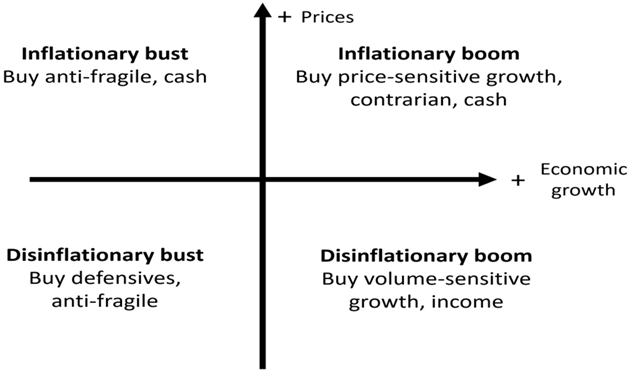Gavekal’s Four Quadrants of Economics is a way to understand how the economy works by looking at two main factors: growth and inflation. Imagine a big box divided into four smaller boxes, or “quadrants.” Each quadrant tells us something different about what’s happening in the economy.
Here’s a simple breakdown:
Quadrant One: Disinflationary Boom = High Growth, Low Inflation
In this quadrant, the economy is doing really well. Businesses are making a lot of money, people are getting jobs, and everything is growing fast. The best part? Prices aren’t going up too much, so things remain affordable. This is like a “golden” period for the economy because it’s expanding without causing problems like high prices.
Quadrant Two: Inflationary Boom = High Growth, High Inflation
Here, the economy is still growing quickly, but there’s a downside: prices are rising fast too. This means more jobs and more money, but it also means that the cost of living goes up. People have to pay more for goods and services, which can be tough. It’s like when everything you want to buy suddenly costs a lot more.
Quadrant Three: Disinflationary Bust = Low Growth, Low Inflation
In this quadrant, the economy isn’t growing much, but at least prices aren’t rising either. Things are stable but not exciting. There are fewer new jobs and businesses aren’t expanding much, but the cost of living stays pretty much the same. It’s like a calm period where not much changes.
Quadrant Four: Inflationary Bust = Low Growth, High Inflation
This is the toughest quadrant. The economy isn’t growing, and to make things worse, prices are going up. People have a hard time finding jobs, and everything costs more. It’s a bad combination because there’s not enough money going around, and the money you do have doesn’t go as far. This situation can make it hard for people to buy what they need.
How to Use the Quadrants
Understanding which quadrant we are in can help businesses and governments make better decisions. For example, in Quadrant One, it might be a good time to invest and expand. In Quadrant Four, people might save money and prepare for harder times.
Why It Matters
Gavekal’s Four Quadrants helps us see the big picture of the economy by focusing on growth and inflation. By knowing which quadrant we are in, we can better understand what’s happening around us and what might happen next. This framework helps everyone, from business leaders to everyday people, plan for the future.

